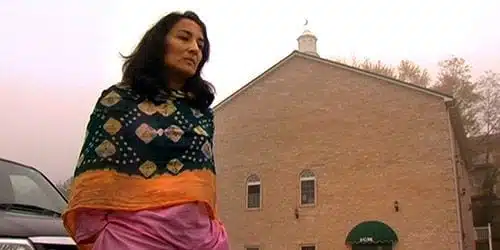
“Sometimes I don’t know why so many people in the community feel they’re forced to take sides.” Christine Arja is making dinner for her young children, speaking over her shoulder to a camera in her kitchen. A Muslim American living in Morgantown, West Virginia, Arja worries about her community, starting with its definition — from within and without.
The problem of being defined by others is hinted at in the first moments of The Mosque in Morgantown: over a long shot of the mosque, a twangy guitar tune slides into a call to prayer. Evoking usual differences between East and West, the soundtrack also suggests their potential combination, two perspectives informing one another to make a new sort of vision. But even as this typical dilemma is so smartly delineated, Brittany Huckabee’s documentary is more closely focused on the tensions immersed within the mosque. The community Arja has described is the one inside the mosque, comprised of multiple nationalities and generations. As mosque member Ihtishaam Qazi says, the group comes from “at least 36 different countries,” with the “two biggest groups being South Asians and then Middle Eastern countries.”
Arja doesn’t talk about her own conversion to Islam, much less her own embodiment of at least some of the community’s many and shifting tensions. But she does describe her changing relationship to the “sides” that form the film’s focus. One might be termed traditional, believing, like Gamal Fahmy, that “In Islam, the woman is usually seen as the one who is more charming, more sexy, more active,” and so, “usually preferred to try to isolate as much as possible.” The other is represented by Asra Nomani.
A journalist and single mother, Nomani was born in Bombay and raised in Morgantown, having moved to this college town when she was 10 and her father was hired as a university professor. “Slowly but surely,” she says, “I saw this conservatism creep into the community in Morgantown. My community was telling me to stay in the corner, stay silent.” In response, Nomani pursued a career that led her to work at the Wall Street Journal and to befriend Daniel Pearl, the journalist who was kidnapped and killed in Kurachi, Pakistan in early 2002. The event, so public and horrific, was a particular and private trauma for Nomani, who had recently been deemed a criminal “in the eyes of Islam” in Pakistan for having a child out of wedlock. Now she saw extremists overtaking the community where she once felt at home. “I knew that I had to bring my son into the world in a safe place,” she recalls, “There was only one place that I thought could be a refuge for us and that was Morgantown.”
As the film indicates, Nomani soon finds herself at odds with the mosque in West Virginia. Told that she is not allowed to enter through the front door, much less pray in the same space with men, she resists, and then some. That is, she organizes women’s reading groups and events, and invites the press — local and CNN — to cover the evolving tensions. Arja remembers that the first protest, when reporters were interviewing women outside the mosque, “was really insane. We were having one media request after another, it was like, ‘Wow, this is really bad coverage,’ and then we see the police show up.”
The controversy expands when Nomani publishes a book, Standing Alone in Mecca: An American Woman’s Struggle for the Soul of Islam, and embarks on a speaking tour (including an appearance on Nightline that hardly endears her to the mosque members who oppose her). With the documentary crew in tow, she does radio interviews and readings, then attends Friday prayers at a mosque in Los Angeles. Here she ruffles more feathers, as one mosque member suggests, “Many people understand your struggle as tied intricately to selling your book.” Nomani doesn’t have a convincing answer here, but she is visibly shaken. “You did not show respect to your people, you did not show respect to yourself,” says an older woman member. Following the confrontation, she takes a “sanity check,” sitting in her car with the camera close on her face. “I drown my sorrow,” she announces, “in an ice cream sundae in a parking lot at McDonalds a block from one of the most progressive mosques in the United States.”
It’s a striking moment, indicating at once the high stakes and sheer absurdity of Nomani’s struggle. Even if it is not hers alone, the film reveals how alone she feels, and how difficult it is for her to have conversations or make “compromises” with those mosque members who urge her to slow down, to let change happen as it surely will. During a much-anticipated town hall meeting at the mosque in Morgantown, they wrestle with the idea of tolerance, namely, who needs to tolerate whom. While Nomani fears a “slippery slope” of intolerance leading to violence, her fellows want to take more time. She walks out, calling their option “ridiculous,” looking angry and intolerant in her own way.
Such moments make clear that the very notion of “sides” is the problem here as neither is able to hear the other. To its credit, Huckabee’s film doesn’t resolve these complications, but rather highlights them. As much as its follows Nomani’s experience, it also notes the discomfort and awakenings her activism brings to friends like Arja. Though Arja initially rejects Nomani’s agitation, now, she says, “I guess I would say I’ve come full circle on this. After working on the council and seeing resistance from certain individuals, I think what she’s done was really needed.” Her husband Mohamad, identified as a “mosque member” in a title, sits quietly beside her during this interview, an image that suggests both his support and her passion for the cause. Even if debate doesn’t lead directly to agreement, the process pushes forward, involving more individuals, expanding the community.

